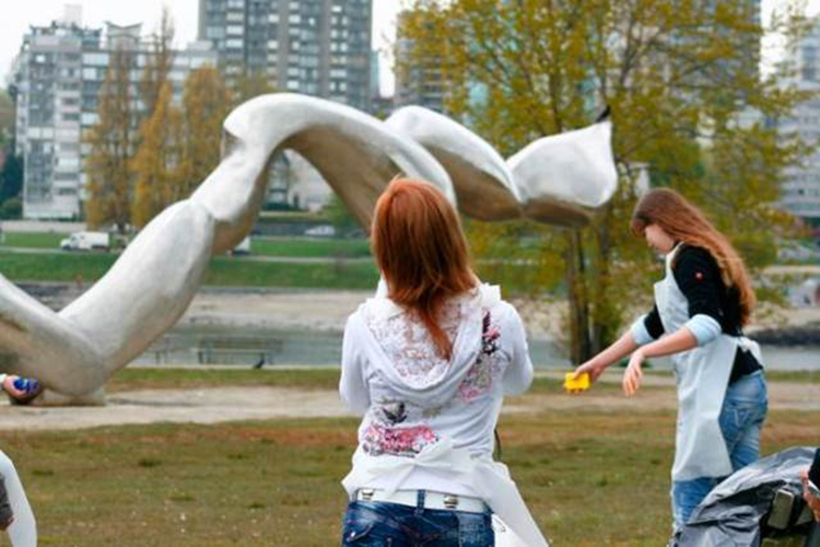Freezing Water #7
Arts Education, Science
Sculpture Title:
Freezing Water #7 and Water #10
Learning Lens:
Human Ingenuity
Curriculum Access:
Science and Art
Big Idea:
Gravity, Forces of Nature and Creativity
Guiding Question:
How does Gravity or other forces of nature influence physical actions/reactions?
Strategies and Approaches:
Senses; Socratic Questioning; informal assessment; prompting; experiential learning, scientific experimentation.
Background for Students:
Rather than creating these sculptures, the artist is actually depicting the creation of nature. In this work his inspiration depicts liquid water stopped in motion to reveal its shape as a drop caught in the air. Learn More.
Informal Assessment:
Via conversation, ensure students devise an experiment where the variables regarding gravity can be measured and compared. Discuss: falling objects; how they fall; with what type of motion; what you know about gravity; how you can find acceleration using a graph of d vs. t.
Materials:
Basketball, tennis ball, volleyball, several 50 mL beakers, water, bowl, plate, wood, tube, water paint, poster paper, and aprons.
Curricular Challenge 1:
The Gravity of the Situation: Dropping Objects – Finding the Acceleration Due to Gravity.
15-20 mins, Open/Reflect: Welcoming Multiple Interpretations
1. Students are encouraged to disengage from their recent experience and their busy surroundings to practice mindfulness.
2. Direct students to ‘mindfully’ (quietly/individually) explore the piece and develop their own interpretation. More information on mindfulness for the classroom can be found here.
3. Direct each student to share their interpretation of the piece without judgment.
4. Connect students’ individual interpretations to the background information provided above.
35 Mins, Challenge: Students to devise an experiment to record acceleration due to gravity (9.8m/s2).
Procedure:
1. Compare the acceleration of water with that of a ball or different objects. What do you notice about how long it takes the water to fall to the ground compared to a tennis ball, or a volleyball or basketball?
2. What is the accepted value for the acceleration of an object due to gravity?
3. Using the available equipment and your imagination devise an experiment to duplicate this.
4. Have students create gravity affected splatter art by utilizing the paint and objects.
Students can use a video camera on their phone to try to replicate and capture the splash. You will have to vary several variables (e.g. paint, height, surfaces) in order to achieve this.
10 mins, Debrief:
Via conversation, debrief students on their recent experience with gravity, nature and creativity. Ask them how their recent experience can contribute towards their knowledge about science?
Another Suggested Activity:
1. Select one object that will be dropped repeatedly from a height of 3m. Designate one team member to climb the step ladder and do the dropping.
2. Measure at least three equally spaced sections of the pole.
3. Time how long it takes for the dropped object to travel through each of the different sections. Keep dropping the object as many times as you need, until you collect your data! Record the length of section (m) and time taken for object to travel through (s) data for Section # 1 to 5 and calculate the speed of the object (m/s) as it passes through each of the different sections.
4. Tabulate the data and calculated results as follow:
Section #
Length of Section (m)
Time taken for object to travel through (s)
Calculated Speed (m/s)
5. Make a graph of speed vs. time using the data in the table. Draw a line-of-best-fit showing the trend of your data (it doesn’t have to go through all the points!) Calculate acceleration by examining the slope of a line of best fit.
6. Conclusion: Hypothesis Statement answering the purpose. Please answer the purpose in the form of a hypothesis.
7. Retest: Now test your hypothesis, track using the motion detector a person’s acceleration due to gravity. Pick a repetitive exercise/motion that someone can do as the motion is measured. Video the person doing the exercise.
